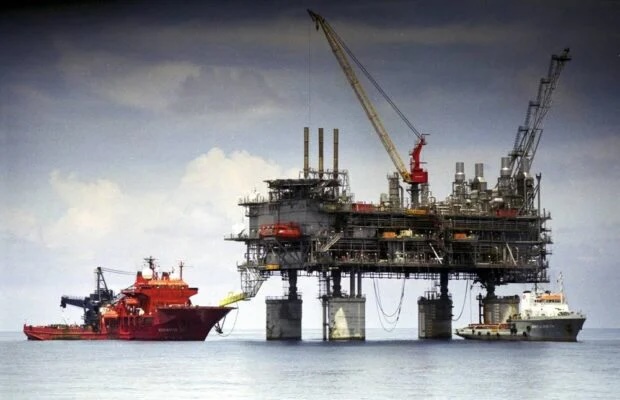PH aims to break ‘deadlock’ in energy talks

The Malampaya topsides, the heaviest and largest integrated platform topsides deck ever built in the Asia Pacific region, is installed using the “float-over” technique 80 kilometers offshore northwest of Palawan. (INQUIRER FILE PHOTO)
MANILA, Philippines — The Philippines is working to resolve its issue with China in the West Philippine Sea to start new energy exploration projects before the Malampaya gas field in Palawan province starts to run out of supply, President Ferdinand Marcos Jr. said in Tokyo on Saturday.
The Malampaya project is one of the country’s most important power assets, producing natural gas for power plants in Batangas City that account for about 40 percent of the total electricity requirements in Luzon and a fifth of the country’s supply.
It began operations in 2001 and the Department of Energy (DOE) had estimated that reserves in the gas field would completely run out by the first quarter of 2027.
“We are still at a deadlock right now. It is in a conflict area. So, that’s another thing that we have to try and resolve to see what role any countries play,” a statement from the Palace quoted the President as saying in an interview with Japanese media about current maritime issues and the Malampaya situation.
“It’s still of course the position of the Philippines that this is not in a conflict area. This is very clearly within our EEZ [exclusive economic zone]…within our baselines, within the maritime territory, the Philippines,” he added.
According to Mr. Marcos, the Philippines has been in negotiation for an exploration deal for more than three years already but admitted that very little progress has been made on the talks.
Transition to renewables
The President noted that the supply of liquefied natural gas (LNG) is becoming more important to the Philippines, particularly as it transitions to renewable energy.
“But this—the move to renewables—I think we are all discovering [it] is not as easy as we had hoped [for] and so we need a transition period to give ourselves time to bring the infrastructure and to allow the technologies to develop,” he added.
“We are seeing LNG as being the transition between purely fossil fuel, coal, to the…bigger mix of renewables,” Mr. Marcos said.
He also pointed out that some of the new technologies were still being pilot-tested, so the Philippines had to wait for them to be rolled out on a commercial basis and this would take a little more time for the country’s transition to clean energy.
He noted that the Philippines has to secure sufficient fuel supply, especially with all his administration’s development plans.
“The supply of reliable, affordable power is always going to be critical and it has been one of the problems that the Philippines has faced,” the President said.
“So, that is what we’ll be working on. That’s why LNG has become more and more important and it’s imperative for the Philippines to find a way to move the process forward so as to be able to assure ourselves of that transition—the fuel supply during that transition period,” he said.
Time running out
The Malampaya project is operated by the SC 38 Consortium led by Prime Energy Resources Development B.V. of ports and gaming tycoon Enrique Razon Jr. The state-owned Philippine National Oil Co.-Exploration Corp. is a member of the consortium.
Early this year, Guillaume Lucci, president and CEO of Prime Energy parent firm Prime Infrastructure Capital Inc., highlighted the urgent need to start developing new wells to produce natural gas, given the depleting reserves of the Malampaya.
“Our drop-dead day to produce new gas or new wells is the first quarter of 2026 and we hope we can actually accelerate that as much as possible,” Lucci said.
In 2021, Sen. Sherwin Gatchalian, head of the Senate Committee on Energy, already warned that the country “could be facing a major energy crisis [in] less than six years unless we find alternative sources to supply our country’s demand for natural gas.”
Legal hurdle
In 2018, the Philippines under then President Rodrigo Duterte and China signed a memorandum of understanding on joint oil and gas development in the West Philippine Sea, ending a ban on such activities imposed by President Benigno Aquino III in 2014 due to maritime tensions with Beijing.
Not much progress happened and with the impending change in administration last year, the DOE ordered anew a suspension in 2022 on oil exploration activities, pending a go-ahead from the Security, Justice, and Peace Coordinating Cluster that also cited “the political, diplomatic and national security implications of any activity in the West Philippine Sea.”
During Mr. Marcos’ state visit to China last January, the Department of Foreign Affairs released a statement saying that Manila and Beijing had agreed to resume exploration discussions in the West Philippine Sea.
In pushing for a joint exploration deal with China, the Marcos administration has to work around a Supreme Court decision in January declaring void and unconstitutional a similar agreement in 2005 that allowed China and Vietnam to jointly explore with the Philippines areas within the country’s EEZ.